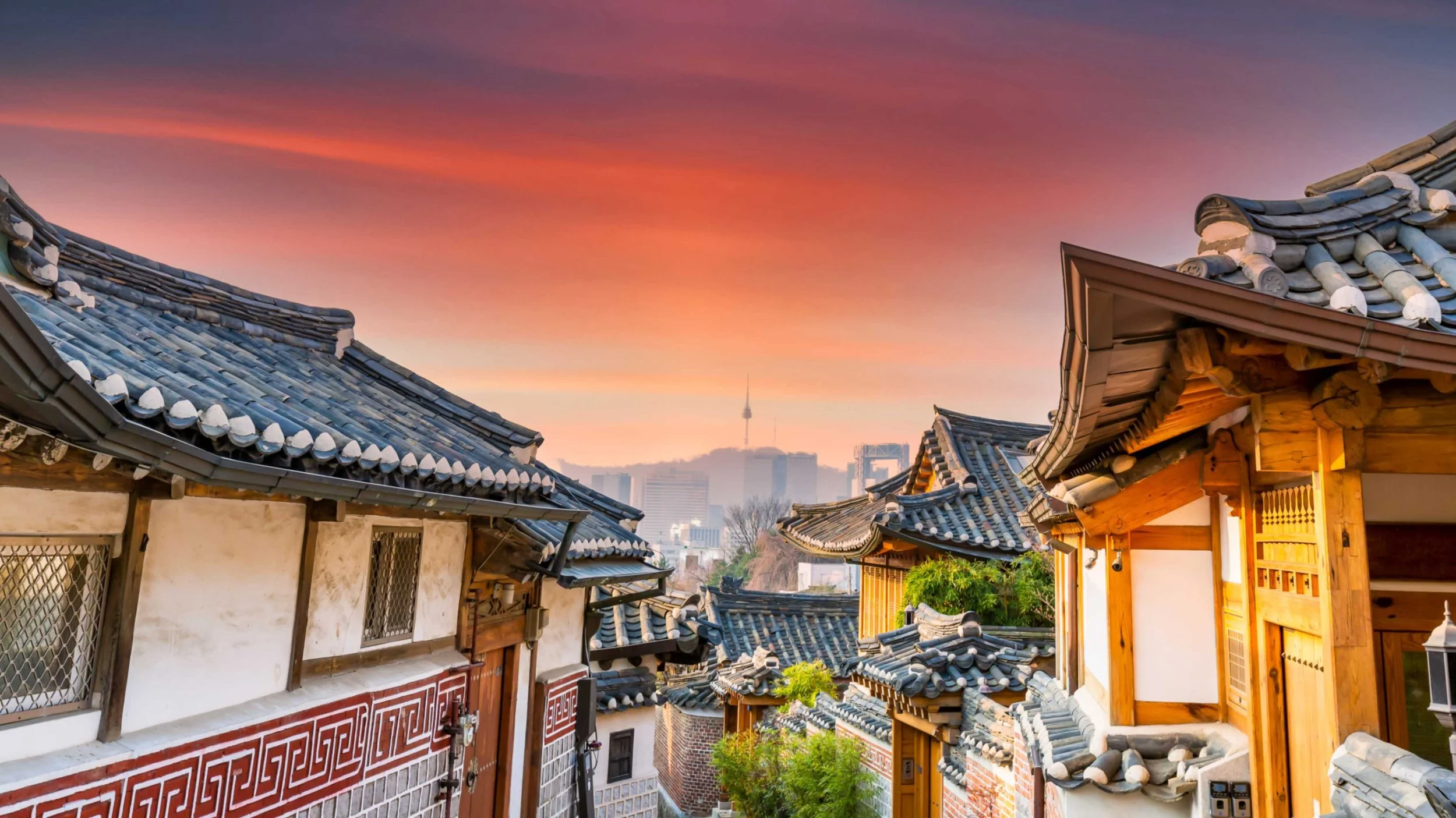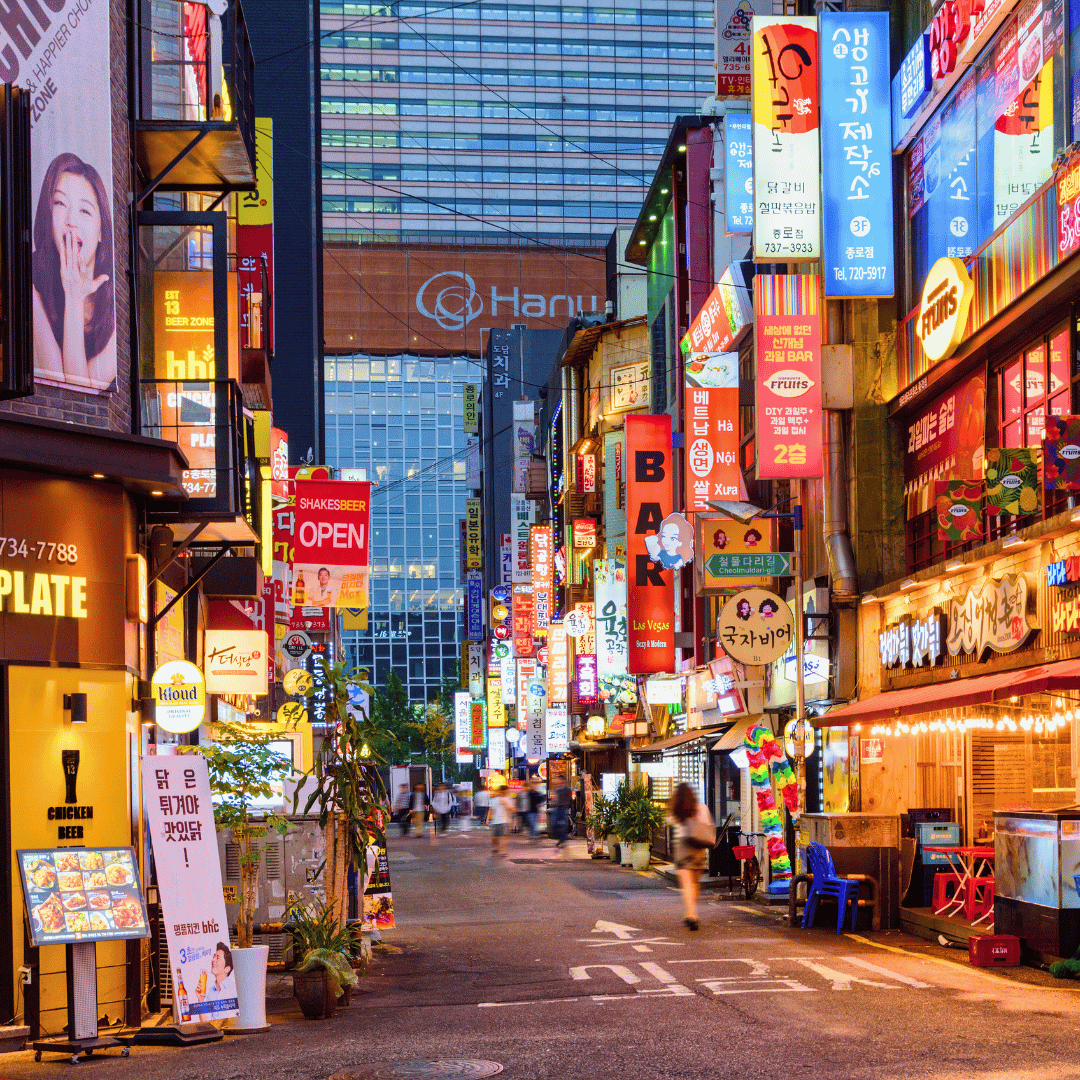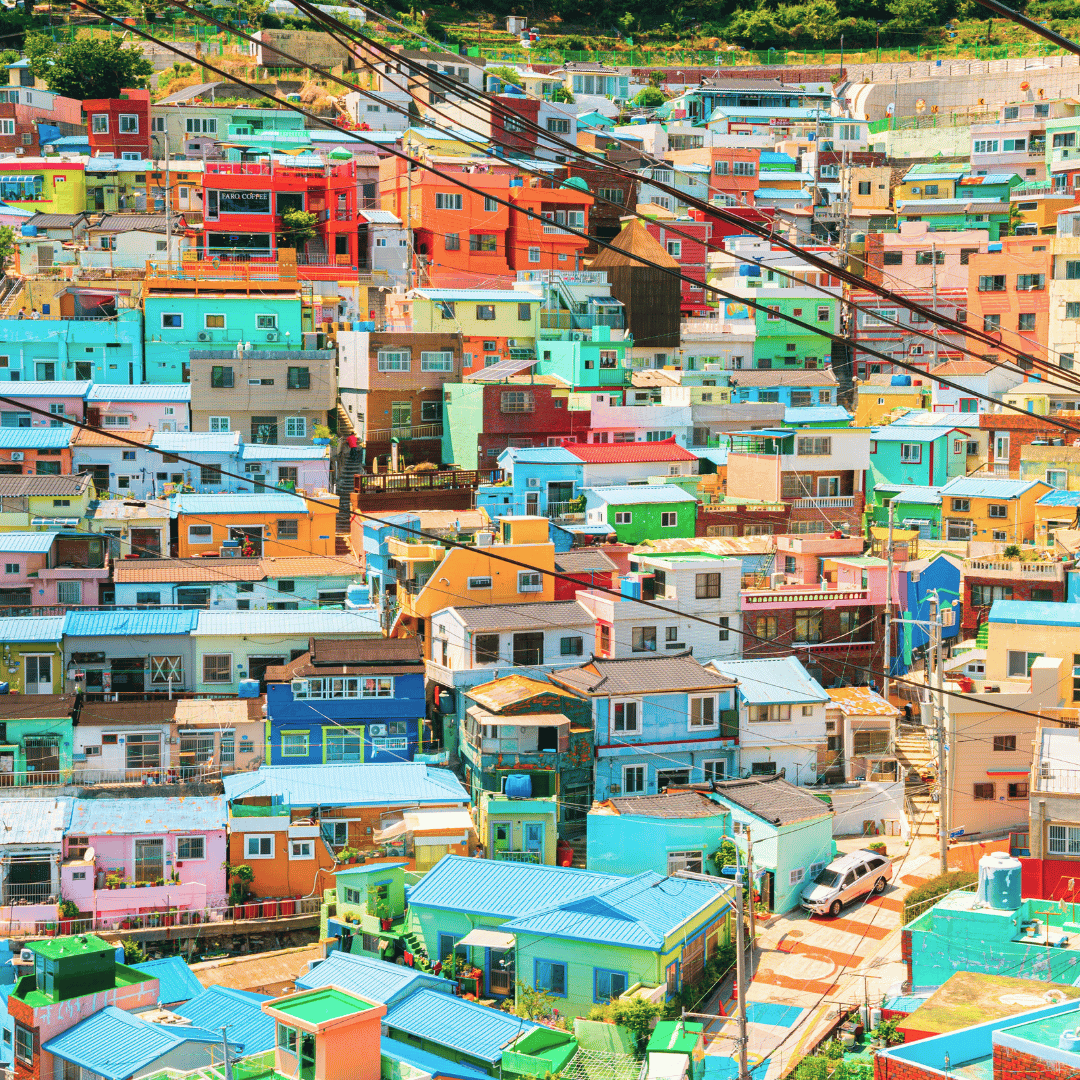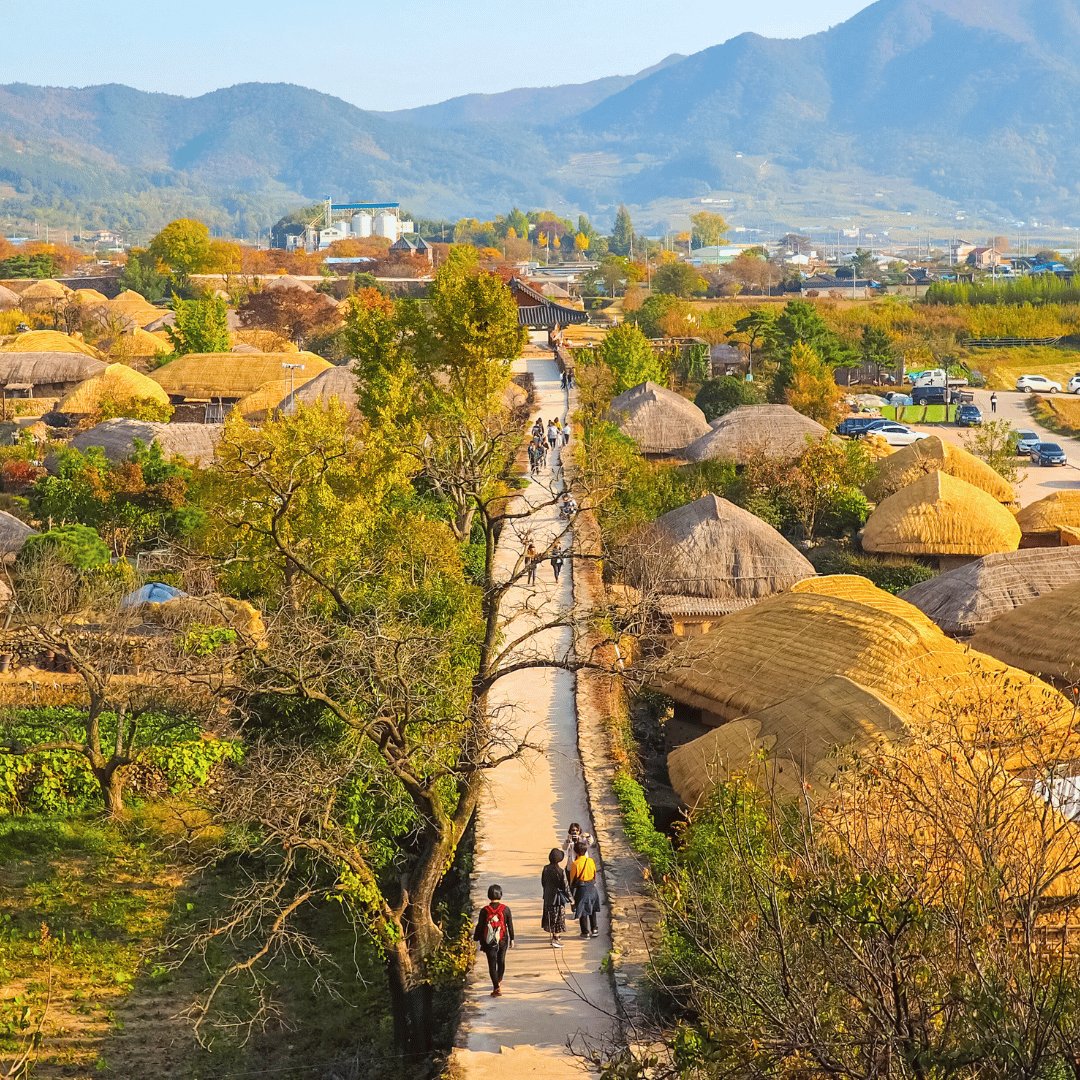
South Korea Private Tour Packages
Bespoke Itineraries Designed For Australian Travellers
South Korea is a country of living history, layered traditions and vivid contrasts, where cutting edge cities blend with sacred mountains and ancient villages. In Seoul, royal palaces and bustling markets sit alongside glass towers and contemporary art spaces, while Gyeongju’s tombs, temples and relics reveal the grandeur of the Silla dynasty. Coastal Busan offers lively seafood markets, hilltop art districts and sweeping ocean views, while Andong preserves Confucian academies, ritual practices and the rhythms of village life. In the east, Seoraksan National Park delivers dramatic peaks, waterfalls and forested trails, while the green tea fields of Boseong and the bamboo groves of Damyang invite moments of calm discovery.
Private tours of South Korea can be tailored to your interests and style, whether that means tracing the frontlines of history at the DMZ, joining a temple stay for insight into Buddhist practice, sampling regional cuisine at traditional markets or relaxing in a seaside town. From vibrant festivals to quiet landscapes, South Korea private tour packages offer an immersive and rewarding way to explore this captivating destination. At Asia Unbound, we design private journeys across Asia for Australian travellers seeking flexible, well planned experiences and genuine cultural connection.
Our Best South Korea Tour Itineraries
South Korea Travel Advice For First Time Visitors
-
South Korea is one of Asia’s most accessible destinations for travellers, combining modern infrastructure with clear entry procedures. For short stays, most visitors including Australians can enter without a visa once they have completed the K-ETA (Korea Electronic Travel Authorisation) online before departure. A Q-Code health declaration is also required prior to travel, and presenting this upon arrival makes clearing immigration quicker. Keeping both confirmations printed and saved on your phone is recommended in case of technical issues.
Getting around the country is straightforward. The high-speed KTX train network links Seoul to cities such as Busan, Gyeongju and Daegu in just a few hours, while frequent buses connect smaller towns and rural areas. Within cities, the subway systems are efficient, affordable and easy to navigate with English signage throughout. T-money or Cashbee cards can be purchased and topped up at convenience stores, making transfers between buses, subways and some taxis seamless. For shorter distances, taxis are safe, metered and reasonably priced, while ride-hailing apps like Kakao Taxi make ordering a car much easier for visitors. Domestic flights are also available if you want to cover longer distances quickly.
The Korean Won (KRW) is the local currency. Credit and debit cards are widely accepted, particularly Visa and Mastercard, but it’s best to carry some cash for street stalls, smaller restaurants and traditional markets. ATMs labelled “Global” usually accept foreign cards and can be found in convenience stores, train stations and airports. Many shops and restaurants now accept mobile payment options as well, though these usually require a local bank account.
Cultural etiquette plays an important role in daily life. Bowing is the standard greeting and reflects respect, while handing items such as gifts, money or business cards with both hands is considered polite. Shoes should be removed before entering homes, guesthouses and some traditional restaurants. On public transport, silence is the norm, and priority seating should always be offered to the elderly or pregnant women. Personal space is respected, though in busy areas like Seoul’s metro stations, crowds are unavoidable. Small gestures like thanking staff, queueing patiently and being mindful of your voice in public all leave a positive impression.
Many travellers are curious about the DMZ, the buffer zone separating North and South Korea. It’s one of the most unique day trips from Seoul and can only be visited on an organised tour with a licensed guide. Tours typically include the Third Infiltration Tunnel, Dora Observatory and Imjingak Park, and give insight into the peninsula’s history and division. While it’s safe to visit and tightly controlled, advance booking is essential as tours are regulated and space is limited.
South Korea is also a very safe country with low levels of crime, but being aware of your belongings in busy markets or on public transport is always wise. Tap water is safe to drink, though many locals prefer bottled water. Public toilets are common and usually free, often stocked with soap and toilet paper, but carrying tissues or sanitiser can be handy in smaller towns. Connectivity is excellent, with widespread free Wi-Fi in cafés, stations and public spaces, and SIM cards or portable Wi-Fi devices are available at airports for constant access.
-
South Korea does not use a state system like Australia or the United States. Instead, the country is divided into a combination of provinces, metropolitan cities, and one special city. This system makes it easy for visitors to understand where cultural and natural highlights are located.
The nine provinces (do) make up the largest areas. These are Gyeonggi-do, Gangwon-do, North Chungcheong (Chungcheongbuk-do), South Chungcheong (Chungcheongnam-do), North Jeolla (Jeollabuk-do), South Jeolla (Jeollanam-do), North Gyeongsang (Gyeongsangbuk-do), South Gyeongsang (Gyeongsangnam-do), and Jeju-do. Each province has its own character - for example, Gangwon is known for its mountains and winter sports, while Jeju is a volcanic island with beaches and hiking trails.
Alongside the provinces are six metropolitan cities (gwangyeoksi). These are Busan, Daegu, Incheon, Gwangju, Daejeon and Ulsan. Each one has the same administrative status as a province but is centred on an urban area. For travellers, this means you can explore dynamic city life in places like Busan’s seaside districts or Incheon’s waterfront developments while still being close to provincial attractions.
Finally, there is one special city (teukbyeolsi), Seoul, which is the country’s capital and largest metropolis. Seoul is separate from surrounding Gyeonggi Province and serves as the cultural, political and economic heart of the nation. It is often the starting point for most journeys through South Korea.
This structure is straightforward for visitors because transport links connect everything efficiently. High-speed KTX trains, express buses and domestic flights make travelling between provinces and cities quick and comfortable. As a result, it is easy to combine Seoul’s modern energy with historic Gyeongju, coastal Busan, or the volcanic landscapes of Jeju within a single travel itinerary.
-
The official language of South Korea is Korean, known locally as Hangugeo. It is written in a distinctive script called Hangul, created in the 15th century and often praised for being logical and simple to learn. Hangul uses 24 basic letters and is designed to be easy for anyone to pick up.
Korean is spoken nationwide, but English is becoming more common in large cities like Seoul, Busan and Incheon. Travellers will notice that transport signs, menus in tourist areas and public announcements at airports and train stations are usually provided in English as well. Younger South Koreans often learn English at school and may be able to help visitors.
Learning a few simple Korean phrases is a great way to connect with locals. The most useful are:
Annyeonghaseyo (ahn-nyong-hah-seh-yo) = Hello
Gamsahamnida (gahm-sah-hahm-nee-dah) = Thank you
Even if you only use these two phrases, people will appreciate the effort and respond warmly.
For visitors who don’t speak Korean, travel is still straightforward. Apps such as Papago for translation and Naver Map or KakaoMap for navigation are widely used and often more accurate than Google Maps in South Korea. With clear bilingual signage, efficient public transport and technology support, language won’t be a barrier to experiencing the country.
-
South Korea is a year-round destination, with each season offering a distinct atmosphere and different experiences for travellers. The most popular times to visit are spring (March to May) and autumn (September to November). These shoulder seasons provide mild, comfortable weather and some of the country’s most memorable scenery. In spring, cherry blossoms and flowering trees line streets, palace gardens and riversides, creating a colourful backdrop to cultural touring. Autumn is equally striking, with crimson and gold foliage blanketing mountain ranges, temples and countryside landscapes, making it a favourite time for hiking and sightseeing. Both seasons are excellent for outdoor touring and city exploration, and they tend to be the busiest with both international visitors and domestic travellers.
Summer (June to August) is warmer and more humid, but it brings an energetic atmosphere. Festivals, fireworks and open-air events are held across the country, while coastal regions and islands like Jeju become popular escapes for locals. This is also the monsoon period, when heavy showers can occur, but travel continues smoothly as South Korea’s infrastructure is well prepared for all conditions. Summer is an appealing time for travellers who enjoy combining city exploration with beach visits or outdoor festivals.
Winter (December to February) transforms South Korea into a destination for snow sports and mountain scenery. The country has a strong skiing and snowboarding culture, with resorts in Gangwon Province offering a range of slopes for beginners and experienced skiers alike. Beyond the mountains, cities such as Seoul and Busan remain lively with museums, galleries, markets and seasonal light festivals. Heated public transport and indoor attractions make urban touring comfortable, even in the coldest months.
Ultimately, the best time to visit depends on your interests and style of travel. Spring and autumn are best for those who want cultural touring and natural beauty at its most vivid. Summer appeals to festival-goers and those interested in coastal escapes, while winter is ideal for travellers looking to ski or enjoy a different perspective of South Korea’s landscapes. With excellent transport connections, modern facilities and year-round activities, South Korea offers something unique in every season.
-
South Korea is a modern country with a strong sense of style, and you’ll notice that people in the cities tend to dress neatly and fashionably. Visitors are not required to follow a strict dress code, but it’s a good idea to wear clean, tidy clothing, especially in urban areas where appearance is taken seriously. Casual wear such as jeans, t-shirts and sneakers is fine for sightseeing, but you may feel more comfortable blending in if you avoid overly worn or revealing clothing.
When visiting temples, palaces or historic sites, modest dress is appreciated. Covering shoulders and knees shows respect, and removing hats or sunglasses when entering religious areas is considered polite. Shoes are often removed before stepping into traditional houses, temples or guesthouses, so wearing footwear that is easy to slip on and off can be practical.
In day-to-day settings, South Koreans value presentation. Locals often dress smartly for work, dining out or even meeting friends, so travellers may wish to pack at least one slightly dressier outfit for evenings or special occasions. In summer, lighter fabrics are fine, though sleeveless tops and very short skirts or shorts may stand out outside tourist areas. In winter, warm coats, scarves and layers are essential, particularly in the north and mountain regions.
Overall, dress in South Korea is about looking presentable and respectful rather than following strict rules. Comfortable clothing works well for touring, but being mindful of context - especially in temples, traditional villages and formal settings - ensures you show awareness of local customs while enjoying your journey.
-
Food is one of the great highlights of visiting South Korea. Meals are central to daily life, and dining here often feels communal, with dishes placed in the centre of the table to be shared. Almost every meal is accompanied by banchan, a collection of small side dishes such as kimchi, pickled vegetables or seasoned greens, that change with the season and the cook. This tradition allows visitors to sample many flavours in a single sitting.
Some of the most recognisable dishes include bibimbap, a rice bowl topped with colourful vegetables, egg and meat, mixed with spicy gochujang sauce, and bulgogi, thin marinated beef grilled or stir fried. Samgyeopsal or grilled pork belly is another favourite, often enjoyed in a barbecue setting where you cook the meat at your own table and wrap it in lettuce leaves with sauces and garlic. Kimchi, Korea’s signature fermented cabbage or radish, is an essential part of almost every meal and has countless regional variations.
For warming comfort food, try one of the many soups and stews. Popular options include kimchi jjigae which is kimchi stew with tofu and pork, doenjang jjigae which is soybean paste stew, and budae jjigae or army stew, a unique dish that blends Korean flavours with ingredients introduced during the Korean War. Noodles are also common, from jajangmyeon which is black bean noodles to naengmyeon which is cold buckwheat noodles, refreshing in summer.
Street food is an essential part of the experience, especially in markets and night districts. Visitors can try tteokbokki which are chewy rice cakes in spicy sauce, hotteok which are sweet filled pancakes, odeng which are fish cakes in broth or skewered meats. Each neighbourhood tends to have its own specialties, and exploring street stalls is an easy way to experience local life.
Regional food is another highlight. Jeonju is famous for its version of bibimbap, Jeju Island for its black pork and citrus, and coastal cities such as Busan for their seafood markets. Travellers with an adventurous palate may also come across dishes like live octopus known as sannakji or traditional medicinal foods, which reflect Korea’s long history of blending cuisine with wellbeing.
Eating in South Korea is not just about the dishes themselves but also the atmosphere. Lively barbecue restaurants, bustling markets and elegant palace style dining all offer different perspectives on the culture. With such variety, travellers can enjoy both familiar and new flavours throughout their journey.
-
The length of your trip to South Korea depends on how much of the country you would like to experience. The transport network is fast and efficient, which means you can see a lot in a short time, but the more days you have, the more variety you can include.
One week is enough for a good introduction. With this time you can explore Seoul’s palaces, markets and modern districts, take a day trip to the Demilitarised Zone, and add a short side trip such as Busan on the coast or Gyeongju for its history. This option works well if you are combining South Korea with another destination in Asia.
Two weeks allows for a balanced journey that mixes cities, countryside and islands. You can spend several days in Seoul, travel south on the high speed train to Busan, visit historic Gyeongju, and then fly to Jeju Island for its volcanic landscapes and outdoor activities. With two weeks you can also include cultural experiences such as a temple stay, cycling in the countryside or visiting traditional villages.
Three weeks or more gives you time for an in depth look at the country. You can follow the classic route of Seoul, Gyeongju, Busan and Jeju Island, but also add less visited regions such as Gangwon Province for mountains and national parks, Andong for Confucian heritage, or smaller coastal towns. This pace lets you travel more slowly, spend extra nights in each place and enjoy activities that are harder to fit into shorter trips.
In short, one week is enough for highlights, two weeks offers a complete overview, and three weeks or more opens up South Korea in greater depth, combining the modern energy of its cities with the traditions and landscapes of its provinces.
-
Yes, South Korea combines easily with nearby destinations, and many travellers choose to extend their journey across Asia for a richer experience. Thanks to excellent regional connections, it is straightforward to design a private tour that includes South Korea alongside another country.
Japan is the most popular partner destination. With frequent direct flights between Seoul, Busan and major Japanese cities such as Tokyo, Osaka and Fukuoka, it is easy to link the two. Travellers often spend a week exploring Seoul, Gyeongju and Busan, before flying across to Japan for a journey through Kyoto’s temples, Hiroshima’s history and Tokyo’s modern districts. The two countries share deep cultural traditions yet feel distinctly different, making them a perfect contrast on one itinerary.
Taiwan is also emerging as a favourite addition. Flights between Seoul and Taipei are short, and Taiwan offers travellers a combination of vibrant city life, mountain scenery and coastal charm. It is particularly appealing for those who want something slightly less visited but still full of culture and natural beauty. Combining South Korea with Taiwan gives you a mix of historic towns, night markets, and impressive landscapes within an easy regional loop.
With Asia Unbound, designing a private tour that combines South Korea with Japan or Taiwan is seamless. Every journey is created from scratch around your interests, ensuring smooth connections, expert local guides and carefully chosen accommodation. Whether you want a short extension or a full three week itinerary across multiple countries, our team will build a trip that highlights the best of each destination while keeping travel comfortable and efficient.
Popular Places To Visit In South Korea
Plan Your South Korea Itinerary With Asia Unbound
Established in 2007, Unbound Travel Group is a collection of tourism brands specialising in highly curated private touring and small group journeys throughout Asia. With more than two decades of experience, we create bespoke itineraries for discerning travellers looking for a real adventure. Based in Australia, our team uses our on-the-ground experience and first-hand knowledge to carefully curate experiences that are innovative and authentic.
When you start to research a trip to Asia, it’s easy to feel overwhelmed by the seemingly endless possibilities, especially if you don’t want to join a group tour. At Asia Unbound, we’ve made this process easy. We simply need you to tell us relevant information about yourself and the type of travel experience you are looking for - whether it’s a wish list of places you want to visit, a style of travel, a particular interest or theme that you want to explore, or all of these factors. Using this information, we curate a custom-made Asia private tour just for you. It’s that simple.
South Korea Hotel Recommendations



















